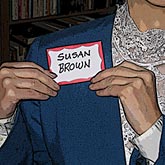Readers weigh in.
 The greatest joy derived from producing monthly newsletters is the response from readers. A recent post, “Conference Attendance Courtesies” sparked several emails about the virtues of magnetic name badge holders. One reader reported she had purchased a magnetic badge holder to have and use at all events, just as I have. Note: This is certainly appropriate unless you have a surgically placed medical device in your body. Indeed because we received so many comments on various aspects of nametag etiquette we’re dedicating this month to the topic:
The greatest joy derived from producing monthly newsletters is the response from readers. A recent post, “Conference Attendance Courtesies” sparked several emails about the virtues of magnetic name badge holders. One reader reported she had purchased a magnetic badge holder to have and use at all events, just as I have. Note: This is certainly appropriate unless you have a surgically placed medical device in your body. Indeed because we received so many comments on various aspects of nametag etiquette we’re dedicating this month to the topic:
Guidelines for writing your own nametag or badge:
1. When preparing nametags, think through the purpose of the nametags. Always show the names in spoken order… that is your given name, followed by your surname or last name, and affiliation. Think twice about the need to provide any information beyond these basics
2. Use only big, bold block letters in all caps or with upper and lower case letters. Avoid script or cursive handwriting and do not add personalized touches that could be confusing. No matter how well-lit a room may be, it is always more difficult to decipher cursive handwriting, particularly by those from other countries or ethnic origins whose first language is not your own.
3. Except for specialized events honorifics and titles are not typically used on nametags. These include Mr., Mrs., Ms. Dr., Ph.D., or M.D.; General Manager, President. Because nametags are intended to quickly show a person’s simple identity, they should only indicate first and last (surname), and affiliation.
“Hello, my name is” nametags:
1. I confess to personally not liking this particular style of nametag. Admittedly, they do serve a purpose for very informal occasions. But, they do seem very elementary and out of place in a professional setting. It’s best to use clean, professional-looking sheets, either with or without colored borders
Squint Factor:
To me, nothing is more disappointing than to attend a conference or professional meeting, only to arrive at check-in and discover the nametags are terribly under-presented — names are printed too small, company affiliation so small you can’t make it out, and every other detail shy of your birth date is loaded onto the badge.
When handwriting your own tag, write your information in a size at least one-quarter inch high. Allow as much white space as possible; it helps others to read the badge more easily.
When generating pre-printed tags on a computer, take care when choosing an appropriate font and font size. For tags I produce personally, I find the 40-point Ariel type is a good starting point for first and last names and affiliations. Sometimes it takes a little extra time to employ a little trial and error to find the correct font size and balance. I assure you it will be well worth the effort for the optimum results.
Use of an affiliation and logo:
Even though it’s important to give due attention to the sponsoring organization, always remember that the most important information on the nametag is the person’s name. By this I mean, the bulk of the space should be devoted to presenting the person’s full name; thus, the scale of the logo or sponsoring affiliation should be much smaller in comparison to the attendee’s name. It should never be the reverse.
Printing the first name larger than the last name:
While there are no hard and fast rules governing whether to enlarge the person’s first name, I submit that it’s best to print both the first and last name in the same size font. With so many men and women sharing the same first name, it can be confusing to see lots of Susans or Stevens walking around. This underscores the value of regarding one’s own name as one’s personal branding vehicle.
Creating your own reusable name badge for use at various events:
While arriving with your very own custom-designed nametag assures your name and affiliation will be presented to your absolute liking, it may not be in your best interest to do so. Consider this: Event planners usually create nametags specific to a particular occasion as a way of identifying—at a glance—those who legitimately belong at the event and those who don’t. By wearing your own personal nametag, you may inadvertently convey the impression of being a party crasher.
Where to place a nametag or badge:
Networking — whether at professional functions or at social events, always wear it on your upper right shoulder. Here’s why:
1. By wearing the tag or badge as high up on your right shoulder as possible it gives other people the best and easiest view of both the tag and your face.
2. As you extend your right hand for a handshake, your eye and arm are already being drawn to the right side of the person you are greeting.
3. Because the uppermost part of your chest is the flattest area below your shoulder, this helps your tag to lie flat and be more secure.
This third point is especially relevant to women. Most of us feel awkward drawing attention to an area of our bodies we would prefer not to be stared at. Placing the tag high in an easy-to-read and visible place, keeps the focus on the tag where it should be.
Company ID badges: Many companies require the staff to wear name badges for instant identification purposes. In this case, it’s customary to wear such badges on the left shoulder.
Placing nametags straight and in plain view:
Never allow your nametag to be worn crooked, sideways, or upside down. It sends a negative message to others, usually implying a lack of respect for the occasion or a lack of care or interest in your personal appearance.
Especially never wear a badge upside down. Though it may sound silly, believe it or not I know a man who deliberately wears his name badge upside down. He claims it’s, “The best way to meet women.” Why? Because he says women will go out of their way to approach him just to help him correct what they perceive as his oversight. My friend claims men are far less likely to mention it or bother helping. Needless to say, I don’t recommend this practice to anyone. In my book this tactic sends the signal, here’s a person who cares little about the image he conveys. Who would want to convey the impression that something as simple as properly wearing a name badge was purposefully missed? …what else might be missing? In other words, while it is possible that one person may take this for humor; another person may take it as incompetence. Why risk creating this kind of confusion?
Question: What other items do you have to add to this list? Do let us hear from you in the area below. You may also reach us at www.AdvancedEtiquette.com. If you enjoyed this article and want more, subscribe to our “Etiquette Tip of the Month” newsletter—at no charge—filled with great monthly tips on all sorts of topics from international business and social etiquette and protocol to everyday life subjects. It will be great to have you as a member of our happy family of subscribers at www.AdvancedEtiquette.com/subscribe.
Happy Practicing!!!
 P.S. To view a video on name tag etiquette, click the link or log onto http://www.youtube.com/watch?v=pmDCb4neM64. As you know, videos are some times more fun and easier to understand. Also for a 10% discount on purchasing name tags and badges, mention Advanced Etiquette when ordering at www.nametag.com
P.S. To view a video on name tag etiquette, click the link or log onto http://www.youtube.com/watch?v=pmDCb4neM64. As you know, videos are some times more fun and easier to understand. Also for a 10% discount on purchasing name tags and badges, mention Advanced Etiquette when ordering at www.nametag.com

When placing name tags on the table for pick up, should a guest of an invitee with a different last name be placed alphabetically, or should it be with the invitees name tag?
Susan: The answer is either way… it’s totally up to you as the organizer. That said, it is always best to inform guests when they register by what method you are using, so they won’t be confused upon arrival. You can also post a sign on the registration table to alert guests of guests where to find their name tag. Thank you for writing.
I really love reading your article very nice and very interesting.
This information is very helpful. However, I have learned it is hard to tell a seasoned professional how wear their name tag.
Direction on wearing nametags with lanyards was not addressed. This is a giant pet peeve of mine. They are worn, hanging down too low, requiring the reader to look at the persons belly or worse. Many times they are turned around and you can't see the name at all. When the attendees sits, the name tag is below the table. How do we convince planners to push for a two clip lanyard with an adjustable size? Then how do we get attendees to shorten them to an appropriate lenghth? This is a touchy subject for many!
Lisa: Thanks for taking the time to write.
I don’t bother giving instructions on how to wear lanyard name badges because they should never be worn at professional events. They are best used ‘only’ at tradeshows and exhibitions, where it doesn’t matter how low they are worn. It’s only for identification. My recommendation is always to have a clip-on or at best a magnetic badge holder, to use and transfer the badge, when at professional and other events, where the true purpose of wearing a name badge is to easily learn a person’s name. Happy Practicing!
What about the staff at a shelter? I've noticed several people who work at Father Joe's Village's are wearing their name badges backwards, so you can't see their names at all.
Hello Adrienne: I am unsure what you mean by wearing a name badge backward. If the issue is not being able to see a name clearly, then perhaps this article will help. Thanks!
This was EXTREMELY helpful. When would it be appropriate to use a job title?
There are also two basic styles of name tags/ badges. when is it appropriate to use a badge with an image vs just a small name plate?
Hello Joshua: Thanks for the post.
A. Using a title is appropriate when everyone at the event is from the same company/organization. Then identifying your title becomes an important bit of information to share.
B. If you are the organizer providing nametags or badges for an event, typically, shorter, less formal events will choose to use a stick-on type, versus longer events, more professional/fancy events may choose to use the badge type. The key to remember is never to use a lanyard badge for any event, except for exhibitions.